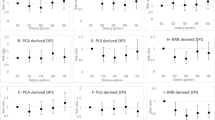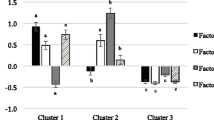Abstract
Purpose
The relative advantages of dietary analysis methods, particularly in identifying dietary patterns associated with bone mass, have not been investigated. We evaluated principal component analysis (PCA), partial least-squares (PLS) and reduced-rank regressions (RRR) in determining dietary patterns associated with bone mass.
Methods
Data from 1182 study participants (45.9% males; aged 50 years and above) from the North West Adelaide Health Study (NWAHS) were used. Dietary data were collected using a food frequency questionnaire (FFQ). Dietary patterns were constructed using PCA, PLS and RRR and compared based on the performance to identify plausible patterns associated with bone mineral density (BMD) and content (BMC).
Results
PCA, PLS and RRR identified two, four and four dietary patterns, respectively. All methods identified similar patterns for the first two factors (factor 1, “prudent” and factor 2, “western” patterns). Three, one and none of the patterns derived by RRR, PLS and PCA were significantly associated with bone mass, respectively. The “prudent” and dairy (factor 3) patterns determined by RRR were positively and significantly associated with BMD and BMC. Vegetables and fruit pattern (factor 4) of PLS and RRR was negatively and significantly associated with BMD and BMC, respectively.
Conclusions
RRR was found to be more appropriate in identifying more (plausible) dietary patterns that are associated with bone mass than PCA and PLS. Nevertheless, the advantage of RRR over the other two methods (PCA and PLS) should be confirmed in future studies.



Similar content being viewed by others
Abbreviations
- AIC:
-
Akaike's information criterion
- BMC:
-
Bone mineral content
- BMD:
-
Bone mineral density
- BMI:
-
Body mass index
- CATI:
-
Computer assisted telephone interview
- DQES:
-
Dietary Questionnaire for Epidemiological Studies
- DXA:
-
Dual energy X-ray absorptiometry
- EFA:
-
Explanatory factor analyses
- FFQ:
-
Food frequency questionnaire
- KMO:
-
Kaiser–Mayer–Olkin
- NHS:
-
National Health Survey
- NWAHS:
-
North West Adelaide Health Study
- PLS:
-
Partial least-squares
- PAL:
-
Physical activity level
- PCA:
-
Principal component analysis
- RRR:
-
Reduced-rank regression
- sTOFHLA:
-
Short test of functional health literacy in adults
- WHO:
-
World Health Organization
References
Waijers PM, Feskens EJ, Ocke MC (2007) A critical review of predefined diet quality scores. Br J Nutr 97:219–231
Arvaniti F, Panagiotakos DB (2008) Healthy indexes in public health practice and research: a review. Crit Rev Food Sci Nutr 48:317–327
Hoffmann K, Schulze MB, Schienkiewitz A, Nothlings U, Boeing H (2004) Application of a new statistical method to derive dietary patterns in nutritional epidemiology. Am J Epidemiol 159:935–944
Newby PK, Tucker KL (2004) Empirically derived eating patterns using factor or cluster analysis: a review. Nutr Rev 62:177–203
Cattell RB (1973) Factor analysis. Greenwood, Westport
Devlin UM, McNulty BA, Nugent AP, Gibney MJ (2012) The use of cluster analysis to derive dietary patterns: methodological considerations, reproducibility, validity and the effect of energy mis-reporting. Proc Nutr Soc 71:599–609
Schulze MB, Hoffmann K (2006) Methodological approaches to study dietary patterns in relation to risk of coronary heart disease and stroke. Br J Nutr 95:860–869
DiBello JR, Kraft P, McGarvey ST, Goldberg R, Campos H et al (2008) Comparison of 3 methods for identifying dietary patterns associated with risk of disease. Am J Epidemiol 168:1433–1443
de Jonge EA, Kiefte-de Jong JC, de Groot LC, Voortman T, Schoufour JD et al (2015) Development of a Food Group-Based Diet Score and Its Association with Bone Mineral Density in the Elderly: The Rotterdam Study. Nutrients 7:6974–6990
van den Hooven EH, Ambrosini GL, Huang R-C, Mountain J, Straker L et al (2015) Identification of a dietary pattern prospectively associated with bone mass in Australian young adults. Am J Clin Nutr 102(5):1035–1043
Melaku YA, Gill TK, Adams R, Shi Z (2016) Association between dietary patterns and low bone mineral density among adults aged 50 years and above: findings from the North West Adelaide Health Study (NWAHS). Br J Nutr 116:1437–1446
Grant JF, Taylor AW, Ruffin RE, Wilson DH, Phillips PJ et al (2009) Cohort profile: the North West Adelaide Health Study (NWAHS). Int J Epidemiol 38:1479–1486
Hodge A, Patterson AJ, Brown WJ, Ireland P, Giles G (2000) The Anti Cancer Council of Victoria FFQ: relative validity of nutrient intakes compared with weighed food records in young to middle-aged women in a study of iron supplementation. Aust N Z J Public Health 24:576–583
Schoenaker DAJM, Dobson AJ, Soedamah-Muthu SS, Mishra GD (2013) Factor analysis is more appropriate to identify overall dietary patterns associated with diabetes when compared with treelet transform analysis. J Nutr 143:392–398
National Heart Foundation, Australian Institute of Health and Welfare (1989) Risk factor prevalence study, Survey no 3. NHF, Canberra
World Health Organization (1995). Physical status: the use and interpretation of anthropometry. Report of a WHO Expert Committee. WHO Technical Report Series 854, Geneva
Australian Bureau of Statistics (2012/13) National nutrition and physical activity survey questionnaire. http://www.abs.gov.au/AUSSTATS/abs@.nsf/DetailsPage/4363.0.55.0012011-13?OpenDocument. Accessed 29 Jan 2016
D’Onise R, Shanahan EM, Gill T, Hill CL (2010) Does leisure time physical activity protect against shoulder pain at work? Occup Med 60:383–388
Weiss BD, Mays MZ, Martz W, Castro KM, DeWalt DA et al (2005) Quick assessment of literacy in primary care: the newest vital sign. Ann Fam Med 3:514–522
Baker DW, Williams MV, Parker RM, Gazmararian JA, Nurss J (1999) Development of a brief test to measure functional health literacy. Patient Educ Couns 38:33–42
Appleton SL, Seaborn CJ, Visvanathan R, Hill CL, Gill TK et al (2013) Diabetes and cardiovascular disease outcomes in the metabolically healthy obese phenotype: a cohort study. Diabetes Care 36:2388–2394
World Health Organization (1994) Assessment of fracture risk and its application to screening for postmenopausal osteoporosis. Report of a WHO Study Group. WHO Tech Rep Ser 843:1–129
Jesudason D, Clifton P (2011) The interaction between dietary protein and bone health. J Bone Miner Metab 29:1–14
Rajatanavin R, Chailurkit L, Saetung S, Thakkinstian A, Nimitphong H (2013) The efficacy of calcium supplementation alone in elderly Thai women over a 2-year period: a randomized controlled trial. Osteoporosis Int 24:2871–2877
Tucker KL, Hannan MT, Chen H, Cupples LA, Wilson PW et al (1999) Potassium, magnesium, and fruit and vegetable intakes are associated with greater bone mineral density in elderly men and women. Am J Clin Nutr 69:727–736
Zhou W, Langsetmo L, Berger C, Poliquin S, Kreiger N et al (2013) Longitudinal changes in calcium and vitamin D intakes and relationship to bone mineral density in a prospective population-based study: the Canadian Multicentre Osteoporosis Study (CaMos). J Musculoskelet Neuronal Interact 13:470–479
Ward KA, Prentice A, Kuh DL, Adams JE, Ambrosini GL (2016) Life course dietary patterns and bone health in later life in a British Birth Cohort Study. J Bone Miner Res 31:1167–1176
Ocke MC (2013) Evaluation of methodologies for assessing the overall diet: dietary quality scores and dietary pattern analysis. Proc Nutr Soc 72:191–199
Rizzoli R (2014) Dairy products, yogurts, and bone health. Am J Clin Nutr 99:1256S–1262S
Shin S, Joung H (2013) A dairy and fruit dietary pattern is associated with a reduced likelihood of osteoporosis in Korean postmenopausal women. The Br J Nutr 110:1926–1933
de Jonge EA, Kiefte-de Jong JC, Hofman A, Uitterlinden AG, Kieboom BC et al (2016) Dietary patterns explaining differences in bone mineral density and hip structure in the elderly: the Rotterdam Study. Am J Clin Nutr 102(5):1035–1043
Kontogianni MD, Melistas L, Yannakoulia M, Malagaris I, Panagiotakos DB et al (2009) Association between dietary patterns and indices of bone mass in a sample of Mediterranean women. Nutrition 25:165–171
Heaney RP (2007) Effects of protein on the calcium economy. Int Congr Ser 1297:191–197
Hayhoe RP, Lentjes MA, Luben RN, Khaw KT, Welch AA (2015) Dietary magnesium and potassium intakes and circulating magnesium are associated with heel bone ultrasound attenuation and osteoporotic fracture risk in the EPIC-Norfolk cohort study. Am J Clin Nutr 102:376–384
van Dam RM, Grievink L, Ocke MC, Feskens EJ (2003) Patterns of food consumption and risk factors for cardiovascular disease in the general Dutch population. Am J Clin Nutr 77:1156–1163
Slattery ML (2010) Analysis of dietary patterns in epidemiological research. Appl Physiol Nutr Metab 35:207–210
Willett W (2013) Nutritional epidemiology. Oxford University, New Work
Pedone C, Napoli N, Pozzilli P, Rossi FF, Lauretani F et al (2011) Dietary pattern and bone density changes in elderly women: a longitudinal study. J Am Coll Nutr 30:149–154
de Franca NA, Camargo MB, Lazaretti-Castro M, Peters BS, Martini LA (2015) Dietary patterns and bone mineral density in Brazilian postmenopausal women with osteoporosis: a cross-sectional study. Eur J Nutr 70(1):85–90
de Jonge EAL, Rivadeneira F, Erler NS, Hofman A, Uitterlinden AG et al (2016) Dietary patterns in an elderly population and their relation with bone mineral density: the Rotterdam Study. Eur J Nutr. doi:10.1007/s00394-016-1297-7
Jankovic N, Steppel MT, Kampman E, de Groot LC, Boshuizen H et al (2014) Stability of dietary patterns assessed with reduced rank regression; the Zutphen Elderly Study. Nutr J. doi:10.1186/1475-2891-13-30
Smith W, Mitchell P, Reay EM, Webb K, Harvey PWJ (1998) Validity and reproducibility of a self-administered food frequency questionnaire in older people. Aust N Z J Public Health 22:456–463
National Cancer Institute. Dietary assessment primer, Effects of measurement error. https://dietassessmentprimer.cancer.gov/concepts/error/error-effects.html. Accessed 1 Feb 2016
Blackwell M, Honaker J, King G (2015) A unified approach to measurement error and missing data overview and applications. Sociol Methods Res. doi:10.1177/0049124115585360
Brenner H, Loomis D (1994) Varied forms of bias due to nondifferential error in measuring exposure. Epidemiology 5:510–517
Acknowledgements
We are thankful to NWAHS participants for their participation in the study. We are grateful for the support provided by Australian Government Research Training Program Scholarship. The NWAHS was funded by The University of Adelaide, the South Australian Department of Health and The Queen Elizabeth Hospital for which the authors are grateful.
Author information
Authors and Affiliations
Contributions
Authors’ contribution
YAM, TKG, RA and ZS conceived the study. YAM conducted all analyses and wrote all drafts of the paper. ZS assisted with analysis and reviewed and provided comment on all drafts. TKG, AWT and RA reviewed and commented on all drafts. All authors read and approved the final manuscript.
Corresponding author
Ethics declarations
Conflict of interest
The authors have no financial or personal conflicts of interest to declare.
Electronic supplementary material
Below is the link to the electronic supplementary material.
Rights and permissions
About this article
Cite this article
Melaku, Y.A., Gill, T.K., Taylor, A.W. et al. A comparison of principal component analysis, partial least-squares and reduced-rank regressions in the identification of dietary patterns associated with bone mass in ageing Australians. Eur J Nutr 57, 1969–1983 (2018). https://doi.org/10.1007/s00394-017-1478-z
Received:
Accepted:
Published:
Issue Date:
DOI: https://doi.org/10.1007/s00394-017-1478-z




